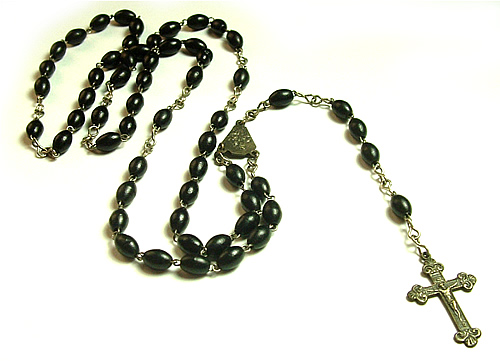 The Rosary is the most popular of Catholic devotional prayers. The name comes from the Latin “rosarium”, or rose garden, which, by the fourteenth century had come to mean a collection of devotional texts. Today it generally refers to the recitation of twenty decades of ten Hail Mary’s each introduced by the Lord’s Prayer and ending with a Doxology. Each decade is accompanied by mediation on either the life of Christ or the life of the Blessed Virgin Mary. The practice of counting the prayers on a string of beads or knots on a string is found in many religious traditions and from patristic times, Christians used this method to assist in the constant repetition of biblical passages. By the eleventh century, the practice of saying 150 Our Fathers instead of the Psalms was widespread among the devout laity. By the twelfth century, as Marian piety increased, the Angelic salutation to Mary from St. Luke’s Gospel was added, as were Elizabeth’s words at the Visitation. The rosary as we know it today, consisting primarily of Hail Marys, seems to have originated with the Carthusians, although it has been, traditionally, a form of prayer associated with the Dominicans and with St. Dominic himself – it is in the writings of a Dominican friar from the middle of the thirteenth century, commenting on earlier writers, that we first find the phrase “the Psalter of Saint Mary”. One of the most effective promoters of the rosary as a devotion was the fifteenth century Dominican, the Breton Alan de la Roche (c. 1425 – 1475) who founded a confraternity of Our Lady and St. Dominic at Douai where he was stationed between 1464 and 1468. He made the saying of the “Psalter of the Virgin Mary” one of the obligations of membership. The Dominican Prior of Cologne, Jacobus Sprenger founded a confraternity in imitation of the one at Douai which, a year after it had begun, claimed to have five thousand members and the following year ten times that number. Within four years, five hundred similar confraternities, linked to Cologne, had been established.
The Rosary is the most popular of Catholic devotional prayers. The name comes from the Latin “rosarium”, or rose garden, which, by the fourteenth century had come to mean a collection of devotional texts. Today it generally refers to the recitation of twenty decades of ten Hail Mary’s each introduced by the Lord’s Prayer and ending with a Doxology. Each decade is accompanied by mediation on either the life of Christ or the life of the Blessed Virgin Mary. The practice of counting the prayers on a string of beads or knots on a string is found in many religious traditions and from patristic times, Christians used this method to assist in the constant repetition of biblical passages. By the eleventh century, the practice of saying 150 Our Fathers instead of the Psalms was widespread among the devout laity. By the twelfth century, as Marian piety increased, the Angelic salutation to Mary from St. Luke’s Gospel was added, as were Elizabeth’s words at the Visitation. The rosary as we know it today, consisting primarily of Hail Marys, seems to have originated with the Carthusians, although it has been, traditionally, a form of prayer associated with the Dominicans and with St. Dominic himself – it is in the writings of a Dominican friar from the middle of the thirteenth century, commenting on earlier writers, that we first find the phrase “the Psalter of Saint Mary”. One of the most effective promoters of the rosary as a devotion was the fifteenth century Dominican, the Breton Alan de la Roche (c. 1425 – 1475) who founded a confraternity of Our Lady and St. Dominic at Douai where he was stationed between 1464 and 1468. He made the saying of the “Psalter of the Virgin Mary” one of the obligations of membership. The Dominican Prior of Cologne, Jacobus Sprenger founded a confraternity in imitation of the one at Douai which, a year after it had begun, claimed to have five thousand members and the following year ten times that number. Within four years, five hundred similar confraternities, linked to Cologne, had been established.
The use of the term “mysteries” to describe the fifteen decades seems to have been first used in 1480 in the statutes of the confraternity established in Venice, which divided them up into the now traditional: Joyful, Sorrowful and Glorious. The practice of attaching themes for meditation while reciting the rosary had been popularised by the Carthusians and had been taken up in the preaching and writing of Ala de la Roche and although the choice of themes and their number remained variable for a long time, the present division had appeared by the end of the fifteenth century.
The practice of a leader and congregation alternating in saying part of the rosary each comes from the Dominican church of Santa Maria sopra Minerva in Rome – a practice that is said to have helped the wording of the second part of the Hail Mary to become fixed.
The visions of Our Lady at Lourdes in 1858 holding a rosary in her hands gave new impetus to the devotion in the second half of the nineteenth century as did the writings of Pope Leo XIII (1878 – 1903) who published no less than twelve encyclicals on it.
St. Pope John Paul II made the most recent change to this popular devotion by the addition of the five Mysteries of Light In his Apostolic Letter "Rosarium Virginis Mariae" (Rosary of the Virgin Mary) issued on the 16th of October 2002 at the beginning of the Year of the Rosary. Text of the Apostolic Letter.
The month of October is traditionally devoted to the rosary and throughout the year the rosary is recited in the Lady Chapel after every weekday Mass in the church and before the Vigil Mass on Saturday evening.